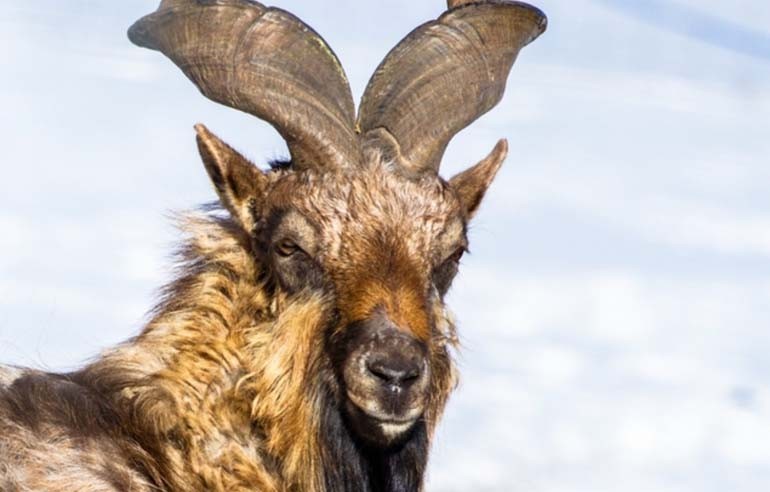
The government decision to not increase the number of trophy hunting licenses before a detailed survey of endangered animals is conducted is a step forward. But will it be complete before the start of the next hunting season in November?

In April, as soon as the melt begins, the trophy hunting season ends, and the mountains in Gilgit-Baltistan, Khyber-Pakhtunkhwa and Balochistan go silent. The hunters reluctantly pack their guns and shells and the community members who earn a living by facilitating the licensed hunters eagerly await the provincial government to dispense their share of money raised through the trophy hunting programme. The wait is usually long.
Trophy hunting in Pakistan is marred with many controversies: on the economic side, due to delayed payments to communities and communities accusing the government officials of favouring other communities; and on the social side, the proper utilisation of the 80 percent share a community receives for facilitating a hunt.
To protect the endangered wild animals from poaching, the government of Pakistan launched the community-based trophy hunting programme in the 1990s, which allows licenses to be granted to hunters. These include blue sheep, ibex and urial and markhor usually found across Gilgit-Baltistan, Kohistan and Chitral and Balochistan. The programme incentivises the local communities for protecting wildlife by giving them 80 percent of the share of the generated funds through licenses. The most sought after license is that of a markhor, which on an average can fetch up to USD100,000. The government gives out 12 licenses per year, four each to Balochistan, Khyber Pakhtunkhwa and Gilgit Baltistan.
Recently, an official from the Ministry of Climate Change informed the members of the Standing Committee on Climate Change of the National Assembly that despite requests for increasing markhor trophy hunt licenses from 12 to 16, the ministry has declined all such proposals until a proper population survey is conducted. He reportedly said, "The numbers of markhor(s) in the wild are possibly on the rise. However, unless there is a fresh census to ascertain their numbers, permits will not be increased. Surveys in the past are too old and incorrect."
Speaking on the quality of surveys done in the past, the official added, "No standardised procedure was followed in the last survey conducted in 2017-18 [by all provinces]. Most surveys [done in the past], including surveys done by World Wide Fund for Nature, Pakistan (WWF-Pakistan) and other non-government organisations (NGOs), are not reliable."
Mujeeb Sardar, Divisional Forest Officer at the Chief Conservator Office in Gilgit, agrees there might be some loopholes in the surveys conducted in the past, but "an exact number can never be ascertained due to the terrain where the animal lives".
Most of the survey reports conducted in the past have been collaborations between the provincial wildlife departments and Wildlife Conservation Society Pakistan, WWF-Pakistan and Snow Leopard Foundation (SLF). "We are welcoming every opinion and are already planning to conduct the next survey after September on the suggestions we receive," he says.
Talking to TNS, Sardar says the wildlife and forest departments are facing problems in rotating the four markhor trophy hunt licenses between the Community Control Hunting Areas (CCHA) spread across Districts Diamer and Nagar in Gilgit-Baltistan. "Our request to increase the license number is purely based on the demand from the CCHA. In the given conditions, it will take us 8-10 years to ensure every CCHA gets a hunt. This also means that during the 8-10 years of rotation cycle, the trophy sized markhor might die or be hunted down illegally," Sardar explains.
He further adds the rotation plan, when revised, will take into consideration the attitude and behaviour of the communities towards the conservation programme, availability of trophy size animal and proper utilisation of the 80 percent share by the community as per their agreement with the government.
Although Sardar’s argument on the method of rotation among the CCHA seems like a viable solution, experts think otherwise. Due to the "sensitivity" of the topic an official from a conservation organisation of Pakistan, while talking to TNS on condition of anonymity, says "On the face of it, the trophy hunting programme seems good for the communities as it generates revenue but how can they operate without a scientific and thorough ecological survey? At present I don’t think the conservation organisations are interested in conducting such a survey since many have shifted focus on livelihood programmes which have more funding opportunities."
In his opinion a mere increase in the number of the animals is not enough to determine the "viability" of a species. "A proper survey must look at the trophy size males, breeding females and juveniles that will replace the trophy size males when they’re hunted down. Unfortunately, there have been instances where breeding males have been shot down resulting in a negative impact on the herd. In the absence of competition, young males mature quickly and copulate which results in passing on poor genes to the future generation," the official emphasises.
Zafar Khan, assistant professor of Environmental Sciences at the Karakoram University in Gilgit, agrees that there has been an increase in the size of animal population in recent years. "There is no doubt the communities reap the socio-economic benefits from the programme. They also have been successful in protecting the animals which were once threatened. But a proper ecological survey must be conducted on a priority basis to clear doubts that shroud the programme."
Experts agree the trophy hunting programme has loopholes and conservation organisations which boasts of starting the programme in the first place should step in to rectify the issues. The jury is still out on the subject of trophy hunting until a proper ecological survey based on scientific evidence is conducted.